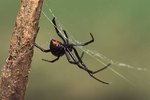
If you suspect a snake has bitten your horse, call your vet at once. Fortunately, most horse snakebites aren't fatal, because of a horse's sheer size. Factors that will determine the outcome include the type of snake and the bite location, the horse's reaction to the venom and how soon after the bite you act.
Snakes
In the United States, the venomous snakes most likely to bite horses include the rattlesnake, water moccasin -- also known as the cottonmouth -- and copperhead. Another type of venomous snake, the coral, is common in the South and could bite a horse. The rattlesnake is a threat if you live in the western part of the country, while the water moccasin and copperhead are found in the eastern and central regions. If you see the snake that bit your horse, take note of the markings, as long as you don't endanger yourself. This information will aid your vet.
Bite Sites
Snakebite usually occurs on the head, especially the nose. Less often, the bite occurs on the leg or chest. Head bites and those on the chest, upper leg or neck are the most severe, because the venom can quickly enter the bloodstream and circulate throughout the body. Bites on the lower leg aren't as dangerous, as this part of the body consists primarily of bone and tendons, with less efficient circulation.
Symptoms
If your horse receives a snakebite on the face, the area will swell up quickly. If he's bitten on or near the nose, there's a chance that the swelling will interfere with his breathing ability. His eyes could also swell shut. Wherever he's bitten, that area will swell. Your horse might experience muscle tremors and weakness, exhibiting obvious signs of pain. Inspect the area for the telltale bite wounds, two small spots roughly 1 inch apart. While it's possible for your horse to be bitten by a nonvenomous snake, these reptiles have tiny teeth, so a reaction to the pain of the bite alone is unlikely.
Treatment
While waiting for your vet, keep your horse confined or otherwise still. The vet will clean the wound and might prescribe antibiotics. She'll also treat your horse's symptoms and administer pain medication and anti-inflammatories to reduce swelling. If your horse isn't current on his tetanus shot, he'll need a vaccination. The vet will take a blood sample to see if the horse has a bad reaction to antitoxins that can disarm the venom. If your vet doesn't think your horse will react negatively, she'll give him the antitoxin intravenously. If your horse is going to die from the bite, it usually happens because of the initial reactions. However, additional complications can manifest. Watch your horse in the coming days for secondary issues, such as laminitis or pneumonia. The skin in the area surrounding the bite might fall off, resulting in an open wound requiring treatment. Your vet can advise you on the appropriate medication for the wound and whether bandaging is necessary.
Precautions
The American Association of Equine Practitioners advises those riding in areas infested with poisonous snakes to carry in their saddlebags two 6-inch-long pieces of garden hose, along with a small amount of personal lubricant. If the horse is bitten and suffers breathing issues, insert the lubricated pieces of hose into the animal's nostrils. This permits the horse to breathe until a vet can treat the swelling.
References
- America's Horse Daily: Snakebite
- Australian Venom Research Unit: Signs of Snake Bite in Horses
- Equisearch: How to Treat Snakebite
- Veresdale Equine Veterinary Services: Snake Bite
- American Association of Equine Practitioners: Snakebit
- Centers for Disease Control and Prevention: Venomous Snakes
- North Carolina State University Cooperative Extension: Top Ten Snake Questions
Photo Credits
-
Jupiterimages/Comstock/Getty Images
Writer Bio
Jane Meggitt has been a writer for more than 20 years. In addition to reporting for a major newspaper chain, she has been published in "Horse News," "Suburban Classic," "Hoof Beats," "Equine Journal" and other publications. She has a Bachelor of Arts in English from New York University and an Associate of Arts from the American Academy of Dramatics Arts, New York City.




